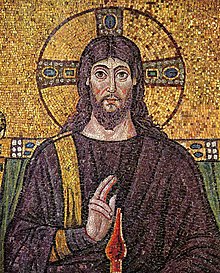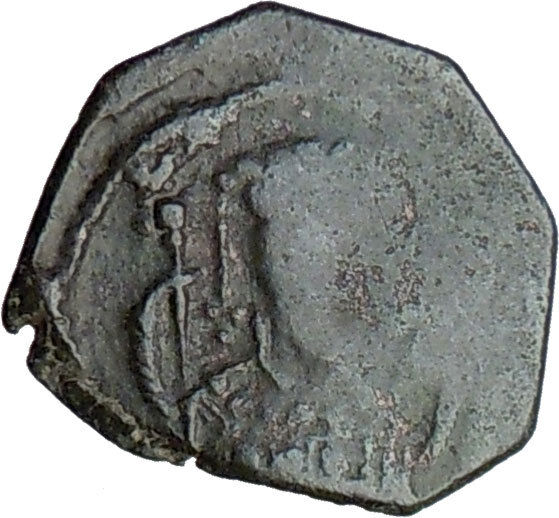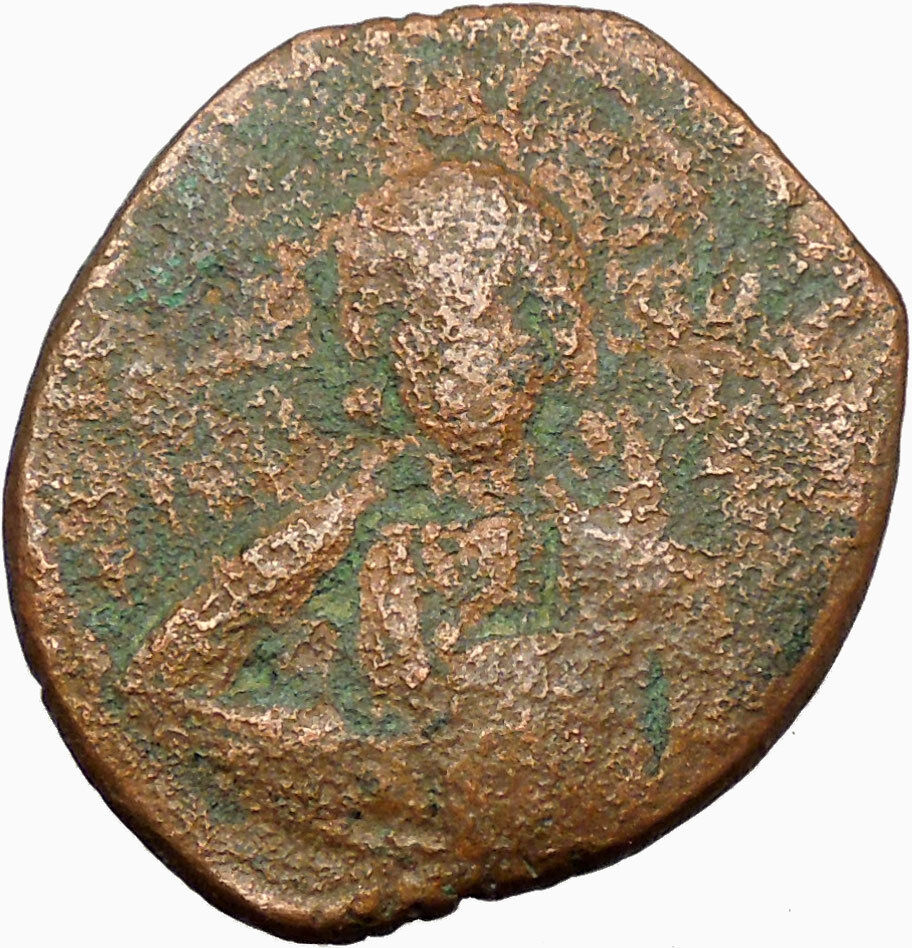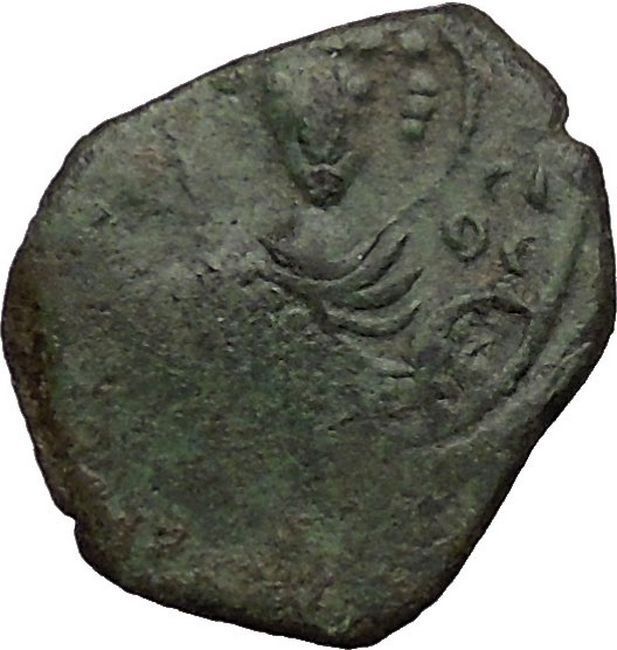|
Byzantine Empire
Anonymous Class
G
Bronze Follis 28mm (6.74
grams)
Struck during the reign of
Romanus IV
, Diogenes –
Byzantine Emperor: 1 January 1068 A.D. – 19 August 1071 A.D.
Reference: Sear 1867
Bust of
Christ
facing , wearing a nimbus crown, pallium and colobium, and
raising right hand in benediction;
in left hand, scroll; to left, IC; to right, XC; border of large pellets.
Facing bust of the
Virgin orans
, nimbate and wearing pallium and maphorium; to
left, MP; to right, ΘV;
border of large pellets.
For more than a century, the production of Follis denomination Byzantine coins
had religious Christian motifs which included included
Jesus Christ, and even Virgin Mary. These coins were designed to honor Christ
and recognize the subservient role of the Byzantine emperor, with many of the
reverse inscriptions translating to “Jesus Christ King of Kings” and “May Jesus
Christ Conquer”. The Follis denomination coins
were the largest bronze denomination coins issued by the Byzantine empire, and
their large size, along with the Christian motif make them a popular coin type
for collectors. This series ran from the period of Byzantine
emperors John I (969-976 A.D.) to Alexius I (1081-1118 A.D.). The accepted
classification was originally devised by Miss Margaret Thompson with her study
of these types of coins. World famous numismatic
author, David R. Sear adopted this classification system for his book entitled,
Byzantine Coins and Their Values. The references about this coin site Mr. Sear’s
book by the number that they appear in that work. The class types of coins
included
Class A1,
Class A2,
Class B,
Class C,
Class D,
Class E,
Class F,
Class G,
Class H,
Class I,
Class J,
Class K. Read more and see examples of these coins by reading the
JESUS CHRIST
Anonymous Class A-N Byzantine Follis Coins Reference.
Click here to see all the Jesus Christ Anonymous Follis coins for sale.
Click here to see all coins bearing Jesus Christ or related available for sale.
You are bidding on the exact
item pictured, provided with a Certificate of Authenticity and Lifetime
Guarantee of Authenticity.
Jesus of Nazareth (c. 5 BC/BCE – c. 30 AD/CE), also
referred to as Jesus Christ or simply Jesus, is the central figure
of
Christianity. Most
Christian denominations
venerate him as
God the
Son
incarnated
and believe that he
rose from the dead
after being
crucified
.

The
principal sources of information regarding Jesus are the four
canonical gospels, and most
critical scholars
find them, at least the
Synoptic Gospels, useful for reconstructing Jesus’ life and
teachings. Some scholars believe apocryphal texts such as the
Gospel of Thomas and the
Gospel according to the Hebrews
are also
relevant
.
Most critical historians agree that Jesus was a
Jew
who was regarded as a teacher and
healer
, that he
was baptized
by
John the Baptist, and
was crucified
in
Jerusalem
on the orders of the
Roman Prefect
Judaea,
Pontius Pilate, on the charge of
sedition
against the Roman Empire
. Critical Biblical scholars and
historians have offered competing descriptions of Jesus as a self-described
Messiah,
as the leader of an apocalyptic movement, as an itinerant sage, as a charismatic
healer, and as the founder of an independent religious movement. Most
contemporary scholars of the
Historical Jesus consider him to have been an independent,
charismatic founder of a Jewish restoration movement, anticipating an imminent
apocalypse. Other prominent scholars, however, contend that Jesus’ “Kingdom
of God” meant radical personal and social transformation instead of a
future apocalypse.
Christians traditionally believe that Jesus was
born of a virgin
:529–32
performed
miracles
,:358–59
founded
the Church
,
rose from the dead
, and
ascended
into
heaven,:616–20
from which he
will return
.:1091–109
Most Christian scholars today present Jesus as the awaited Messiah promised in
the
Old Testament and as God, arguing that he fulfilled many Messianic
prophecies of the Old Testament
. The majority of Christians
worship Jesus as the incarnation of God the Son, one of three divine persons of
a reject Trinitarianism
Trinity, wholly or partly,
believing it to be non-scriptural.
The Virgin Orans, Oranta (The Great
Panagia)
(Ukrainian:
Оранта) is a well-known
Orthodox Christian
depiction of the
Virgin Mary
in prayer with extended arms. It is
stored in the
Saint Sophia Cathedral in Kiev
in

Ukraine.
The 6 meter high mosaic
is located in the vault of the chancel.
The icon has been present in the Cathedral since its foundation by
Yaroslav I the Wise
in the 12th century.
The Virgin’s solemn and static posture, the characteristic folds of her
garments, and her pensive expression indicate the design was strongly influenced
by
Byzantine art.
The image is considered as one of the greatest sacred symbols in Ukraine, a
palladion
defending the people of the country.
It has been called an “Undestructible Wall” or “Unmoveable Wall”. Legend says
that as long as the Theotokos
is extending Her arms over
Kiev,
the city will stand indestructible.
The
embroidered
handkerchief on the belt of the
Mother of God is popularly thought to be for wiping away the tears of those who
come before her with their problems and concerns.
In 1997 the National Bank of Ukraine
issued commemorative
coins “Orante” (“Oranta”) within the “Spiritual Treasures of Ukraine” series.
Romanos IV Diogenes or Romanus IV Diogenes (Greek: Ρωμανός
Δ΄ Διογένης, Rōmanos IV Diogenēs) was a member of the
Byzantine
military aristocracy who, after his marriage to the widowed
empress
Eudokia Makrembolitissa
was crowned
Byzantine emperor
and reigned from 1068 to 1071. During his reign he was
determined to halt the decline of the Byzantine military and stop Turkish
incursions into the Byzantine Empire, but in 1071 he was captured and his army
routed at the
Battle of Manzikert
. Upon his capture he was overthrown in a palace coup,
and when released he was quickly defeated and detained by members of the
Doukas
family.
In 1072, he was blinded and sent to a monastery where he died of his wounds.
//
Accession
to the throne
Romanos Diogenes was the son of
Constantine Diogenes
and a member of a prominent and powerful
Cappadocian
family, connected by birth to most of the great aristocratic nobles in
Asia Minor
. Courageous and generous, but also quite impetuous, his military
talents had seen him rise with distinction in the army, but he was eventually
convicted of attempting to usurp the throne of the sons of
Constantine X
Doukas in 1067. While waiting to receive his sentence from the
regent
Eudokia Makrembolitissa
, he was summoned into her presence and advised that
she had pardoned him and that furthermore she had chosen him to be her husband
and the guardian of her sons as emperor. She took this course of action firstly
due to her concern that unless she managed to find a powerful husband, she could
easily lose the regency to any unscrupulous noble, and secondly because she was
infatuated with the popular Romanus. Her decision was met with little protest as
the Seljuk
Turks had overrun much of Cappadocia and had even taken the important city of
Caesarea
,
meaning that the army needed to be placed under the command of an able and
energetic general.
The problem Romanus and Eudokia had in executing this plan was that Eudokia’s
deceased husband, Constantine X, had made her swear an oath never to remarry.
She approached the
Patriarch
John Xiphilinos
and convinced him both to hand over the written oath she had
signed to this effect, and to have him pronounce that he was in favour of a
second marriage for the good of the state. The
Senate
agreed,
and on January 1, 1068 Romanus married the empress and was crowned Emperor of
the Romans.
Campaigns
against the Turks
Romanus IV was now the senior emperor and guardian of his stepsons and junior
co-emperors,
Michael VII
,
Konstantios Doukas
, and
Andronikos Doukas
. However, his elevation had antagonised not only the
Doukas
family,
in particular the
Caesar
,
John Doukas
who led the opposition of the palace officials to Romanos’
authority, but also the
Varangian Guard
, who openly expressed their discontent at the marriage of
Eudokia. Romanos therefore decided that he could only exercise his authority by
placing himself at the head of the army in the field, thereby focusing the whole
government’s attention on the war against the Turks.
By 1067
, the
Turks had been making incursions at will into
Mesopotamia
,
Melitene
, Syria
,
Cilicia
and
Cappadocia, culminating with the sack of Caesarea and the plundering of the
Church of
St Basil
. That winter they camped on the frontiers of the empire, and waited
for the next year’s campaigning season. Romanos was confident of Byzantine
superiority on the field of battle, looking on the Turks as little more than
hordes of robbers who would melt away at the first encounter. He did not take
into account the degraded state of the Byzantine forces which had suffered years
of neglect from his predecessors, in particular Constantine X. His forces,
mostly composed of
Sclavonian
,
Armenian
,
Bulgarian
,
and Frankish
mercenaries, were ill-disciplined, disorganised and uncoordinated, and he was
not prepared to spend time in upgrading the arms, armour or tactics of the once
feared Byzantine army.
Campaign
of 1068
The first military operations of Romanos did achieve a measure of success,
reinforcing his opinions about the outcome of the war.
Antioch
was
exposed to the
Saracens
of Aleppo
who, with help from Turkish troops, began an attempt to reconquer the
Byzantine province of Syria. Romanos began marching to the southeastern frontier
of the empire to deal with this threat, but as he was advancing towards
Lykandos
,
he received word that a Seljuk army had made an incursion into
Pontus
and
plundered Neocaesarea
. Immediately he selected a small mobile force and quickly raced
through
Sebaste
and
the mountains of
Tephrike
to encounter the Turks on the road, forcing them to abandon their
plunder and release their prisoners, though a large number of the Turkish troops
managed to escape.
Returning south, Romanos rejoined the main army and they continued their
advance through the passes of
Mount Taurus
to the north of
Germanicia
and proceeded to invade the
Emirate
of
Aleppo. Romanos captured
Hierapolis
which he fortified in order to provide protection against further incursions
into the south-eastern provinces of the empire. He then engaged in further
fighting against the Saracens of Aleppo but neither side managed a decisive
victory. With the campaigning season reaching its end, Romanos returned north
via
Alexandretta
and the
Cilician Gates to
Podandos
. Here he was advised of another Seljuk raid into
Asia
Minor
which saw them sack
Amorium
, but
they had returned to their base so fast that Romanos was in no position to give
chase, and he eventually reached
Constantinople
by
January
1069.
Campaign
of 1069
Plans for the following year’s campaigning were initially thrown into chaos
by a rebellion by one of Romanos’
Norman
mercenaries
, Crispin, who led a contingent of Frankish troops in the pay of
the empire. Possibly due to Romanos not paying them on time, they began
plundering the countryside near where they were stationed, and attacking the
imperial tax collectors. Although Crispin was captured and exiled to
Abydos
, the Franks continued to ravage the
Armeniac Theme
for some time. In the meantime, the land around Caesarea was
again overrun by the Turks, forcing Romanos to spend precious time and energy in
expelling the Turks from Cappadocia. Desperate to begin his campaign proper, he
ordered the execution of all prisoners, even a Seljuk chieftain who offered to
pay an immense ransom for his life. Having brought a measure of peace to the
province, Romanos marched towards the
Euphrates
via
Melitene
, and crossed the river at
Romanopolis
, hoping to take
Akhlat
on Lake Van
and thus protect the Armenian frontier.
Romanos placed himself at the head of a substantial body of troops, and began
his march towards Akhlat, leaving the bulk of the army under the command of
Philaretos Brachamios
with orders to defend the Mesopotamian frontier.
Philaretos was soon defeated by the Turks, whose advance on
Iconium
forced
Romanos to abandon his plans and return to Sebaste. He sent orders to the
Dux of Antioch to
secure the passes at
Mopsuestia
,
while he attempted to run down the Turks at
Heracleia
.
The Turks were soon hemmed in the mountains of
Cilicia
, but
managed to escape to Aleppo after abandoning their plunder. Romanos once again
returned to Constantinople without the great victory he was hoping for.
Affairs
at Constantinople
The year 1070
saw Romanos detained at Constantinople while he dealt with many outstanding
administrative issues, including the imminent fall of
Bari into
Norman
hands. They had been besieging it since 1068, but it had taken
Romanos two years to finally get around to doing anything about it. He ordered a
relief fleet to set sail, containing sufficient provisions and troops to enable
them to hold out for much longer. But the fleet was intercepted and defeated by
a Norman squadron under the command of
Roger
, the
younger brother of
Robert Guiscard
,
forcing the final remaining outpost of Byzantine authority in
Italy
to
surrender on April 15, 1071.
While this was playing out, Romanos was undertaking a number of unpopular
reforms at home. He reduced a great deal of unnecessary public expenditure that
was wasted on useless court ceremonials and beautifying the capital. He reduced
the public salaries that were paid to much of the court nobility, as well as
reducing the profits of tradesmen. His preoccupation with the military had also
made him unpopular with the provincial governors and the military hierarchy, as
he was determined to ensure they could not abuse their positions, especially
through corrupt practices. He incurred the displease of the mercenaries by
enforcing much need discipline. Romanos was also deeply unpopular with the
common people, as he neglected to entertain them with games at the
hippodrome
, nor did he alleviate the burdens of the peasants in the
provinces. All this animosity would help his enemies when the time came that
they moved against him.
Nevertheless, he did not forget his principal target, the Turks. Being unable
to go on campaign himself, he entrusted the imperial army to one of his
generals,
Manuel Komnenos
, nephew of the former emperor
Isaac I
, and elder brother to the future emperor
Alexios
. He managed to engage the Turks in battle, but was defeated and
taken prisoner by a Turkish general named
Khroudj
. Manuel convinced Khroudj to go to Constantinople and see Romanos in
person in order to conclude an alliance, which was soon completed. This act
motivated the Seljuk Sultan
Alp Arslan
to attack the Byzantine Empire, besieging and capturing the important Byzantine
fortress of
Manzikert
.
Battle
of Manzikert and capture by Alp Arslan
Early in the spring of 1071, Romanos marched at the head of a large army with
the intent of recovering Manzikert. It was soon evident that the army had a
serious discipline problem, with soldiers regularly pillaging the area around
their nightly camps. When Romanos attempted to enforce some stricter discipline,
a whole regiment of German mercenaries mutinied, which the emperor only managed
to control with the greatest difficulty.
Believing that Alp Arslan was nowhere near Manzikert, he decided to divide
his army. One part of the army he dispatched to attack Akhlat, at that time in
possession of the Turks. Romanos himself advanced with the main body of the army
on Manzikert, which he soon recaptured. At this point his advance guard met the
Seljuk army which was rapidly approaching Manzikert. Romanos ordered the forces
attacking Akhlat to rejoin the army, but their portion of the army unexpectedly
came across another large Turkish army, forcing their retreat back into
Mesopotamia. Already under strength, Romanos’ army was further weakened when his
Uzes mercenaries deserted to the Turks.
Arslan had no desire to take on the Byzantine army, and so proposed a peace
treaty with favourable terms for Romanos. The emperor, eager for a decisive
military victory, rejected the offer, and both armies lined up for a battle that
took place on August 26, 1071. The battle lasted all day without either side
gaining any decisive advantage when the emperor ordered a part of his centre to
return to camp but the order was misunderstood by the right wing.
Andronikos Doukas
, who commanded the reserves, was the son of Caesar John
Doukas, and he took advantage of the confusion to betray Romanos by marching
away from the battle with some 30,000 men instead of covering the emperor’s
retreat, claiming that Romanos was dead. The Turks now began to press in on the
Byzantine army.
When Romanos discovered what had happened, he tried to recover the situation
by making a defiant stand. He fought valiantly when his horse was finally killed
from under him. Receiving a wound in the hand which prevented him from wielding
a sword, he was soon taken prisoner.
According to a number of Byzantine historians, including
John Skylitzes
,
Arslan at first had difficulty believing the dusty and tattered warrior brought
before him was the Roman Emperor. He then stepped down from his seat and placed
his foot on Romanos’ neck. But after this sign of ritual humiliation, Arslan
raised Romanos from the ground, and ordered him to be treated like a king. From
then on he treated him with extreme kindness, never saying a cruel word to him
in the Emperor’s eight-day stay in his camp, and who then released him in
exchange for a treaty and the promise of a hefty ransom. At first Alp Arslan
suggested a ransom of 10,000,000
nomismata
to Romanos IV, but later reduced it to 1,500,000 nomismata
with a further 360,000 nomismata annually.
Betrayal
In the meantime, the opposition faction scheming against Romanos IV decided
to exploit the situation. The Caesar John Doukas and
Michael Psellos
forced Eudokia to retire to a monastery, and easily prevailed upon Michael VII
to declare Romanos IV deposed. They then refused to honor the agreement made
between Arslan and the former emperor. Romanos soon returned and he and the
Doukas family gathered troops. A battle was fought at
Doceia
between Constantine and Andronikos Doukas and Romanos, in which the
army of Romanos was defeated, forcing him to retreat to the fortress of
Tyropoion
, and from there to
Adana
in Cilicia.
Pursued by Andronikos, he was eventually forced to surrender by the garrison at
Adana upon receiving assurances of his personal safety. Before leaving the
fortress, he collected all the money he could lay his hands on and sent it to
the Sultan as proof of his good faith, along with a message: “As emperor, I
promsed you a ransom of a million and a half. Dethroned, and about to become
dependent upon others, I send you all I possess as proof of my gratitude.”
Andronikos stipulated that his life would be spared if he resigned the purple
and retired into a monastery. Romanos agreed, and this agreement was ratified at
Constantinople. However, John Doukas reneged on the agreement, and sent men to
have Romanos
cruelly blinded
on (June 29, 1072), before sending him into exile to
Kınalıada
in the
Sea of Marmara
.
Leaving him without an assistant, his wound became infected, and he was soon
enduring a painfully lingering death. The final insult was given a few days
before his death, when Romanos received a letter from John Doukas,
congratulating him on the loss of his eyes. He finally died, praying for the
forgiveness of his sins, and his wife Eudokia was permitted to honor his remains
with a magnificent funeral.
Family
By his first wife Anna, a daughter of
Alusian of
Bulgaria
, Romanos IV Diogenes had at least one son:
- Constantine Diogenes, who was married to Theodora, sister of
Alexios I
Komnenos
. This marriage was arranged by
Anna Dalassena
after the death of Romanos IV, but it was shortlived, as
Constantine perished under the walls of
Antioch
in 1073 while serving with his brother-in-law Isaac Komnenos.
By his second wife, the Empress
Eudokia Makrembolitissa
, he had:
-
Nikephoros Diogenes
- Leo Diogenes
|










